CBSE Class 12 Maths Chapter-12 Important Questions - Free PDF Download
Download free PDF of Important Questions for CBSE Class 12 Maths Chapter 12 - Linear Programming prepared by expert Maths teachers from the latest edition of CBSE (NCERT) books. Register online for Maths tuition on Vedantu.com to score more marks in CBSE board examination.
Class 12 Maths Chapter 12 Linear Programming is an important chapter that students should provide attention to. This chapter develops the fundamental concepts related to linear programming that will be very useful in the future. To make this chapter easier to prepare, download and solve the CBSE Class 12 Maths Chapter 12 Linear programming Important Questions developed by the experts. Refer to the solutions to learn the answering methods and score more in the exams.



Study Important Questions for class 12 Mathematics Chapter 12 – Linear Programming
Long Answer Type Questions (6 Marks)
1. Solve the following L.P.P. graphically
Minimise and maximise $\quad {\text{z}} = 3x + 9y$
Subject to the constraints $\quad x + 3y \leqslant 60$
$x + y \geqslant 10$
$x \leqslant y$
$x \geqslant 0,y \geqslant 0$
Ans:
Maximize $Z = 3x + 9y$
Minimize $Z = 3x + 9y$
Subject to,
$\begin{array}{*{20}{c}} {x + 3y \leqslant 60} \\ {x + y \geqslant 10} \\ {x \leqslant y} \\ {x \geqslant 0,\quad y \geqslant 0} \end{array}$
\[x{\text{ }} + {\text{ }}3y{\text{ }} \leqslant {\text{ }}60\]
X | 0 | 60 |
y | 20 | 0 |
\[x{\text{ }} + {\text{ }}y{\text{ }} \geqslant {\text{ }}10\]
X | 0 | 10 |
y | 10 | 0 |
\[x{\text{ }} \leqslant {\text{ }}y\]
X | 0 | 20 |
y | 0 | 20 |
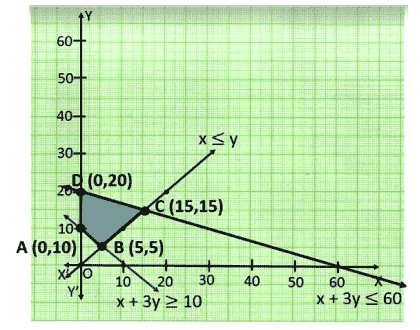
Corner points | Value of Z |
(0,10) | 90 |
(5,5) | 60 |
(15,15) | 180 |
(0,20) | 180 |
$\therefore {\text{Z}} = 60$ is minimum at $(5,5)$
Also,
$Z$= 60 is maximum at two points $(15,15){\text{ \& }}(0,20)$
$\therefore {\text{Z}} = 180$ is maximum at all points joining $(15,15){\text{ \& }}(0,20)$.
2. Determine graphically the minimum value of the objective function z = – 50x + 20 y, subject to the constraints
Ans:
Minimum $Z = - 50x + 20y$
Subject to,
$\begin{array}{*{20}{l}} {2x - y \geqslant - 5} \\ {3x + y \geqslant 3} \\ {2x - 3y \leqslant 12} \\ {x \geqslant 0,y \geqslant 0} \end{array}$
\[2x{\text{ }}--{\text{ }}y \geqslant - 5\]
x | 0 | 1 |
y | 5 | 7 |
\[3x{\text{ }}--{\text{ }}3y \geqslant 3\]
X | 1 | 0 |
y | 0 | 3 |
\[2x{\text{ }}--{\text{ }}3y \leqslant 12\]
X | 6 | 9 |
y | 0 | 2 |
(Image will be uploaded soon)
Corners points | Value of Z |
(0,5) | 100 |
(0,3) | 60 |
(1,0) | -50 |
(6,0) | -300 |
As the region that is feasible is unbounded.
Hence $ - 300$ may or may not be the minimum value of $Z$.
To check this, we graph inequality.
$ - 50x + 20y < - 300$
X | 6 | 8 |
y | 0 | 5 |
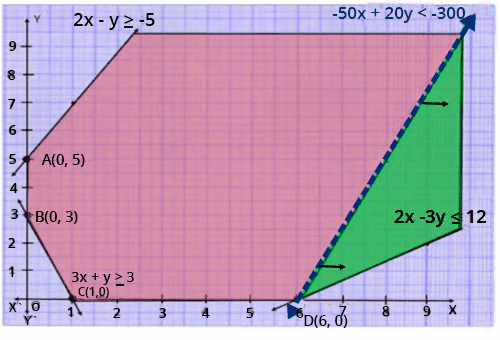
As, there are some common points between the feasible region
the inequality.
Hence, \[300\]is not the minimum value of $Z$.
$\therefore {\mathbf{Z}}$ has no minimum value.
3. Two tailors A and B earn \[{\mathbf{Rs}}.{\text{ }}{\mathbf{150}}{\text{ }}{\mathbf{and}}{\text{ }}{\mathbf{Rs}}.{\text{ }}{\mathbf{200}}\] per day respectively. A can stitch 6 shirts and 4 pants per day, while B can stitch \[{\mathbf{10}}{\text{ }}{\mathbf{shirts}}{\text{ }}{\mathbf{and}}{\text{ }}{\mathbf{4}}{\text{ }}{\mathbf{pants}}\]per day. Formulate the above L.P.P. mathematically and hence solve it to minimize the labour cost to produce at least \[{\mathbf{60}}{\text{ }}{\mathbf{shirts}}{\text{ }}{\mathbf{and}}{\text{ }}{\mathbf{32}}{\text{ }}{\mathbf{pants}}\].
Ans:
Let Tailor A work for x days
Tailor ${\text{B}}$ work for y days
Given that
Two tailors $A$ and $B$ earn \[150{\text{ }}and{\text{ }}200\]per day respectively.
And, we need to minimize labour cost
So, our equation will be
$\therefore {\text{Z}} = 150{\text{x}} + 200{\text{y}}$
Now, according to question
A can stitch 6 shirts and 4 pants per day, while $B$ can stitch 10 shirts
and 4 pants per day. We need to minimize the labour cost to produce
at least 60 shirts and 32 pants and solve it graphically
Shirts Pants
Min Shirts = 60 Min Pants = 32
\[\begin{array}{*{20}{l}} {6x{\text{ }} + {\text{ }}10y \geqslant 60\;\;\;\;\;\;\;\;\;\;\;\;\;4x{\text{ }} + {\text{ }}4y \geqslant 32} \\ {3x{\text{ }} + {\text{ }}5y \geqslant 30\;\;\;\;\;\;\;\;\;\;\;\;\;\;\;x{\text{ }} + {\text{ }}y \geqslant 8} \end{array}\]
Also,
\[x \geqslant 0,{\text{ }}y \geqslant 0\]Combining all constraints:
$\operatorname{Min} Z = 150x + 200y$
Subject to constraints,
\[\begin{array}{*{20}{l}} {3x{\text{ }} + {\text{ }}5y \geqslant 30} \\ {x{\text{ }} + {\text{ }}y \geqslant 8} \\ {\& {\text{ }}x \geqslant {\text{ }}0,{\text{ }}y{\text{ }} \geqslant {\text{ }}0} \end{array}\]
\[3x{\text{ }} + {\text{ }}5y \geqslant 30\]
X | 10 | 0 |
y | 0 | 6 |
\[x{\text{ }} + {\text{ }}y \geqslant 8\]
X | 8 | 0 |
y | 0 | 8 |

Corner Points | Z = 150x + 200y |
A (10,0) | 1500 |
B (5,3) | 150(5) + 200(3) = 1350 |
C (0,8) | 1600 |
As the region that is feasible is unbounded.
Hence \[1350\]may or may not be the minimum value of $Z$.
To check this, we graph inequality.
$\begin{array}{*{20}{l}} {150x + 200y \leqslant 1350} \\ {{\text{ i}}{\text{.e}}{\text{. }}3x + 4y \leqslant 27} \\ {3x + 4y \leqslant 27} \end{array}$
\[3x{\text{ }} + {\text{ }}4y \leqslant 27\]
X | 9 | 0 |
y | 0 | 6.75 |

As there is no common point between the feasible region & the
inequality.
Hence, 1350 is the minimum value of $Z$.
Hence, cost will be minimum if
Number of days tailor $A$ works for $ = 5$
Number of days tailor $B$ works for $ = 3$
Minimum Cost = \[Rs{\text{ }}1350\] at 5 days of A and 3 days of B.
4. There are two types of fertilizer’s A and B. A consists of 10% nitrogen and 6% phosphoric acid and B consists of 5% nitrogen and 10% phosphoric acid. After testing the soil conditions, a farmer finds that he needs at least 14 kg of nitrogen and 14 kg of phosphoric acid for his crop. If A costs Rs. 6 kg and B costs Rs. 5 kg, determine how much of each type of fertilizer should be used so that nutrient requirements are met at minimum cost. What is the minimum cost?
Ans:
Let the fertilizer ${{\text{F}}_1}$ requirement be x kg
fertilizer ${{\text{F}}_2}$ requirement be y kg
Fertilizer | Nitrogen | Phosphoric Acid | Quantity | Cost |
F1 | 10 % | 6% | X kg | Rs 6 |
F2 | 5% | 10% | Y kg | Rs 5 |
Total | 14 kg | 14kg |
According To questions:
Nitrogen | Phosphoric Acid |
Nitrogen in F1 = 10% Phosphoric in F2 = 5% Minimum Available = 14 kg 10% of x + 5% of y ≥ 14 2x + y ≥ 280 | Acid in F1 = 6% Acid in F2 = 10% Minimum Available = 14 kg 6% of x + 10% of y ≥ 14 3x + 5y ≥ 700 |
Also, \[x{\text{ }} \geqslant {\text{ }}0,{\text{ }}y \geqslant {\text{ }}0\]
As we need to Minimize the cost,
hence the function used here is Minimize $z$.
Cost of fertilizer ${{\text{F}}_1} = $ Rs 6 kg
Cost of fertilizer ${{\text{F}}_2} = $ Rs 5 kg
Minimize $z = 6x + 5y$
Combining all Constraints:
$\operatorname{Min} Z = 6x + 5y$
Subject to constraints
$\begin{array}{*{20}{l}} {2x + y \geqslant 280} \\ {3x + 5y \geqslant 700} \\ {x,y \geqslant 0} \end{array}$
\[2x{\text{ }} + {\text{ }}y \geqslant 280\]
X | 140 | 0 |
y | 0 | 280 |
\[3x{\text{ }} + {\text{ }}5y \geqslant 700\]
X | 0 | 700/3 |
Y | 140 | 0 |
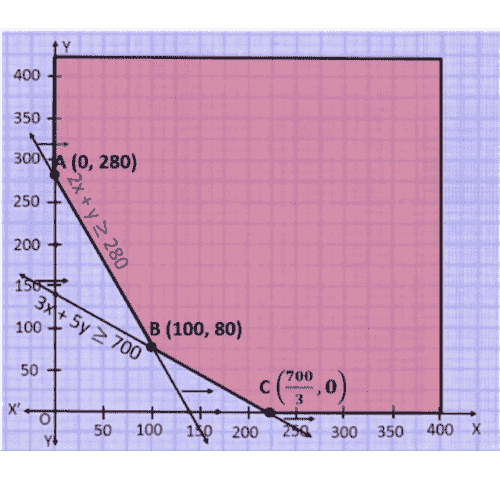
Corner Points | Value of Z |
(0,280) | 1400 |
(100,80) | 1000 |
(700/3,0) | 1400 |
As the feasible area is unbounded
Hence 1000 may or may not be the minimum value of $Z$.
For this, we need to graph inequality
X | 500/3 | 0 |
Y | 0 | 200 |

Since, there is no common point between the feasible region and
$6x + 5y < 1000$
Hence the cost will be minimum, if
Fertilizer ${{\text{F}}_1}$ used $ = 100\;{\text{kg}}$
Fertilizer ${{\text{F}}_2}$ used 8= 80kg
Minimum Cost = Rs 1000.
5. A man has Rs. 1500 to purchase two types of shares of two different companies S1 and S2. Market price of one share of S1 is Rs 180 and S2 is Rs. 120. He wishes to purchase a maximum of ten shares only. If one share of type S1 gives a yield of Rs. 11 and of type S2 yields Rs. 8 then how much shares of each type must be purchased to get maximum profit? And what will be the maximum profit?
Ans:
Let the S1 purchased be x and S2 purchased be y
Then, \[180x{\text{ }} + {\text{ }}120y < = {\text{ }}1500\]
Also, \[x{\text{ }} + {\text{ }}y{\text{ }} < = 10\]
\[x > = 0{\text{ }}and{\text{ }}y > = 0\]
\[Profit{\text{ }} = {\text{ }}11x{\text{ }} + {\text{ }}8y\]
Now, if you will draw the graph using the 4 constraint equations mentioned above,
the common region would be a closed surface with A (0,0), B (8.33,0), C (5,5), D (0,10)
Hence, the profit would be maximum at one of the vertices only
\[\begin{array}{*{20}{l}} {Profit{\text{ }}at{\text{ }}A{\text{ }}\left( {0,0} \right){\text{ }} = {\text{ }}11\left( 0 \right){\text{ }} + {\text{ }}8\left( 0 \right){\text{ }} = {\text{ }}0} \\ {Profit{\text{ }}at{\text{ }}B{\text{ }}\left( {8.33,0} \right){\text{ }} = {\text{ }}11\left( {8.33} \right){\text{ }} + {\text{ }}8\left( 0 \right){\text{ }} = {\text{ }}91.63} \\ {Profit{\text{ }}at{\text{ }}C{\text{ }}\left( {5,5} \right){\text{ }} = {\text{ }}11\left( 5 \right){\text{ }} + {\text{ }}8\left( 5 \right){\text{ }} = {\text{ }}95} \\ {Profit{\text{ }}at{\text{ }}D{\text{ }}\left( {0,10} \right){\text{ }} = {\text{ }}11\left( 0 \right){\text{ }} + {\text{ }}8\left( {10} \right){\text{ }} = 80} \\ \; \end{array}\]
Hence, the maximum profit is Rs 95 at point C and hence, the man should purchase 5 Share of S1 and S2 to maximise his profit.
6. A company manufactures two types of lamps say A and B. Both lamps go through a cutter and then a finisher. Lamp A requires 2 hours of the cutter’s time and 1 hours of the finisher’s time. Lamp B requires 1 hour of cutter’s and 2 hours of finisher’s time. The cutter has 100 hours and finishers has 80 hours of time available each month. Profit on one lamp A is Rs. 7.00 and on one lamp B is Rs. 13.00. Assuming that he can sell all that he produces, how many of each type of lamps should be manufactured to obtain maximum profit?
Ans:
Let the company manufacture $x$ cutters of type $A$ and $y$ finishers of type $B$.
Therefore,
$x \geqslant 0$ and $y \geqslant 0$
The given information can be complied in a table as follows.
Lamp A | Lamp B | Availability | |
Cutter | 2 | 1 | 100 |
Finisher | 1 | 2 | 80 |
The profit on type A cutters is Rs 5 and on type B finishers is Rs 6. Therefore, the
constraints are
$2x + y \leqslant 100$
$x + 2y \leqslant 80$
Total profit, $z = 7x + 13y$
The mathematical formulation of the given problem is Maximize $z = 7x + 13y \ldots (1)$
subject to the constraints, $2x + y \leqslant 100$... (2)
$x + 2y \leqslant {80_ \ldots }$
$x,y \geqslant 0 \ldots $ (4)
The feasible region determined by the system of constraints is as follows.
(Image will be uploaded soon)
As per the constraints the feasible solution is the shaded region. Possible points for maximizing ${\text{Z}}$ are $A(0,40),B(40,20),C(50,0)$
$\begin{array}{*{20}{l}} {{\text{Z}}{]_A} = 7 \times 0 + 13 \times 40 = 520} \\ {{\text{Z}}{]_B} = 7 \times 40 + 13 \times 20 = 540} \\ {{\text{Z}}{]_C} = 7 \times 50 + 13 \times 0 = 350} \end{array}$
Hence profit is maximum of Rs 540 when the dealer purchases 40 Lamp A and 20 Lamp B.
7. A dealer wishes to purchase a number of fans and sewing machines. He has only Rs. 5760 to invest and has space for almost 20 items. A fan and sewing machine cost Rs. 360 and Rs. 240 respectively. He can sell a fan at a profit of Rs. 22 and sewing machine at a profit of Rs. 18. Assuming that he can sell whatever he buys, how should he invest his money to maximize his profit?
Ans:
Let the no. of fans purchased by the dealer $ = {\text{x}}$
and number of sewing machines purchased $ = {\text{y}}$
then the L.P.P. is formulated as
$Z = 22x + 18y$ to be maximised subject to constraints
$\begin{array}{*{20}{l}} {x + y \leqslant 20} \\ {360x + 240y \leqslant 5760} \end{array}$ $...(i)$ (space only for 20 items)
$ \Rightarrow \quad 3x + 2y \leqslant 48$ $ \ldots (ii)$
$x \geqslant 0,y \geqslant 0$ $ \ldots (iii)$
We plot the graph of the constraints.
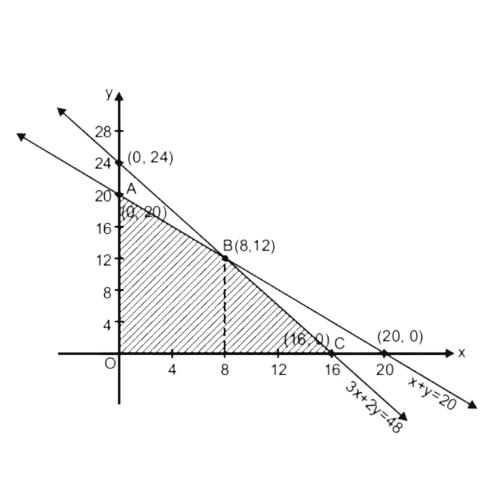
As per the constraints the feasible solution is the shaded region. Possible points for maximising $Z$ are $A(0,20),B(8,12),C(16,0)$
$\begin{array}{*{20}{l}} {{\text{Z}}{]_A} = 22 \times 0 + 18 \times 20 = 360} \\ {{\text{Z}}{]_B} = 22 \times 8 + 18 \times 12 = 392} \\ {{\text{Z}}{]_C} = 22 \times 16 + 18 \times 0 = 352} \end{array}$
Hence profit is maximum of Rs 392 when the dealer purchases 8 fans and 12 sewing machines.
8. If a young man rides his motorcycle at 25 km/h, he has to spend Rs. 2 per km on petrol. If he rides at a faster speed of 40 km/h, the petrol cost increases to Rs. 5 per km. He has Rs. 100 to spend on petrol and wishes to find the maximum distance he can travel within one hour. Express this as L.P.P. and then solve it graphically.
Ans:
Let young man drives $x\;{\text{km}}$ at a speed of 25 km/ hr. and y km at a speed of 40km/hr.
Clearly,
$x,y \geqslant 0$
It is given that, he spends Rs 2 per km if he drives at a speed of $25\;{\text{km}}/{\text{hr}}$ and Rs 5 per km if he drives at a speed of $40\;{\text{km}}/{\text{hr}}$. Therefore, money spent by him when he travelled $x\;{\text{km}}$ and $y\;{\text{km}}$ are Rs 2x and Rs 5y respectively.
It is given that he has a maximum of Rs 100 to spend.
Thus, $2x + 5y \leqslant 100$
Time spent by him when travelling with a speed of $25\;{\text{km}}/{\text{hr}} = \dfrac{x}{{25}}{\text{hr}}$
Time spent by him when travelling with a speed of $40\;{\text{km}}/{\text{hr}} = \dfrac{y}{{40}}{\text{hr}}$
Also, the available time is 1 hour.
$\dfrac{x}{{25}} + \dfrac{y}{{40}} \leqslant 1$
Or, $40x + 25y \leqslant 1000$
The distance covered is $Z = x + y$ which is to be maximized.
Thus, the mathematical formulation of the given linear programming problem is $\operatorname{Max} Z = x + y$ subject to
$2x + 5y \leqslant 100$
$40x + 25y \leqslant 1000$
$x,y \geqslant 0$
First, we will convert inequations as follows:
$2x + 5y = 100$
$40x + 25y = 1000$
$x = 0$ and $y = 0$
The region represented by $2x + 5y \leqslant 100$
The line $2x + 5y = 100$ meets the coordinate axes at $A(50,0)$ and $B(0,20)$ respectively. By joining these points, we obtain the line $2x + 5y = 100$. Clearly $(0,0)$ satisfies the $2x + 5y = 100.$ So, the region which contains the origin represents the solution set of the inequation $2x + 5y \leqslant 100$
The region represented by $40x + 25y \leqslant 1000$
The line $40x + 25y = 1000$ meets the coordinate axes at $C(25,0)$ and $D(0,40)$ respectively. By joining these points, we obtain the line $2x + y = 12$. Clearly $(0,0)$ satisfies the $40x + 25y = 1000$. So, the region which contains the origin represents the solution set of the inequation $40x + 25y \leqslant 1000$
The region represented by $x \geqslant 0,y \geqslant 0$ :
Since every point in the first quadrant satisfies these inequations. So, the first quadrant is the region represented by the inequations $x \geqslant 0$ and $y \geqslant 0$.
The feasible region determined by the system of constraints
$2x + 5y \leqslant 100,40x + 25y \leqslant 1000,x \geqslant 0$ and $y \geqslant 0$ are as follows
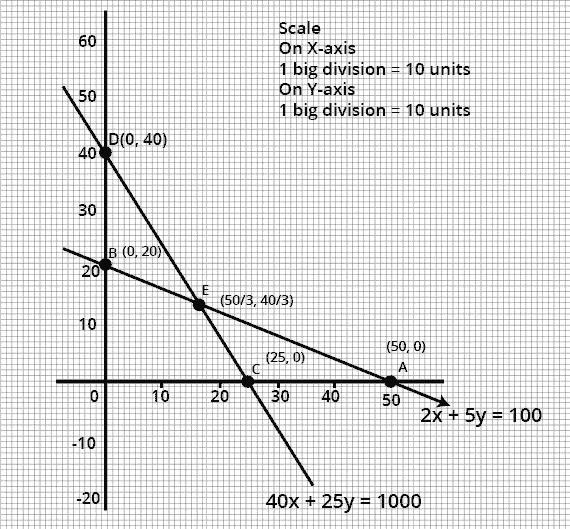
The corner points are O (0, 0), B (0, 20), E (50 3, 40 3), (503,403), and C (25, 0). The value of Z at these corner points are as follows:
Corner Points | Z = x + y |
(0,0) | 0 |
(0,20) | 20 |
(50/3,40/3) | 30 |
(25,0) | 25 |
The maximum value of $Z$ is 30 which is attained at $E$.
Thus, the maximum distance travelled by the young man is $30{\text{kms}}$, if he drives $\dfrac{{50}}{3}$ ${\text{km}}$ at a speed of $25\;{\text{km}}/{\text{hr}}$ and $\dfrac{{40}}{3}\;{\text{km}}$ at a speed of $40\;{\text{km}}/{\text{hr}}$.
9. A producer has 20 and 10 units of labour and capital respectively which he can use to produce two kinds of goods X and Y. To produce one unit of X, 2 units of capital and 1 unit of labour is required. To produce one unit of Y, 3 units of labour and one unit of capital is required. If X and Y are priced at Rs. 80 and Rs. 100 per unit respectively, how should the producer use his resources to maximize the total revenue?
Ans:
Let ${x_1}$ and ${y_1}$ units of goods $x$ and $y$ were produced respectively. Number of units of goods cannot be negative.
Therefore,
${x_1},{y_1} \geqslant 0$
To produce one unit of x, 2 units of labour and for one unit of y, 1 units of labour are required $2{x_1} + {y_1} \leqslant 20$ To produce one unit of x, 3 units of capital is required and 1 unit of capital is required to produce one unit of $y$ $3{x_1} + {y_1} \leqslant 10$
If $x$ and $y$ are priced at Rs 80 and Rs 100 per unit respectively,
Therefore, cost of ${x_1}$ and ${y_1}$ units of goods $x$ and $y$ is Rs $80{x_1}$ and Rs $100{y_1}$respectively.
Total revenue $ = Z = 80{x_1} + 100{y_1}$ which is to be maximized.
Thus, the mathematical formulation of the given linear programming problem is $\operatorname{Max} {\text{Z}} = 80{x_1} + 100{y_1}$
subject to $2{x_1} + {y_1} \leqslant 20$
$3{x_1} + {y_1} \leqslant 10$
$x,y \geqslant 0$
First, we will convert inequations into equations as follows:
$2{x_1} + {y_1} = 20,3{x_1} + {y_1} = 10,x = 0$ and $y = 0$
Region represented by $2{x_1} + {y_1} \leqslant 20$ :
The line $2{x_1} + {y_1} = 20$ meets the coordinate axes at $A(10,0)$ and $B(0,20)$ respectively. By joining these points, we obtain the line
$2{x_1} + {y_1} = 20.$
Clearly $(0,0)$ satisfies the $2{x_1} + {y_1} = 20.$ So, the region which contains the origin represents the solution set of the inequation $2{x_1} + {y_1} \leqslant 20$
Region represented by $3{x_1} + {y_1} \leqslant 10$ :
The line $3{x_1} + {y_1} = 10$ meets the coordinate axes at
$C\left( {\dfrac{{10}}{3},0} \right)$ and $D(0,10)$ respectively.
By joining these points, we obtain the line $3{x_1} + {y_1} = 10.$
Clearly $(0,0)$ satisfies the inequation $3{x_1} + {y_1} \leqslant 10.$
So, the region which contains the origin represents the solution
set of the inequation $3{x_1} + {y_1} \leqslant 10$
Region represented by ${x_1} \geqslant 0$ and ${y_1} \geqslant 0$ :
Since, every point in the first quadrant satisfies these inequations. So, the first quadrant is the region represented by the inequations $x \geqslant 0$, and $y \geqslant 0$.
The feasible region determined by the system of constraints $2{x_1} + {y_1} \leqslant 20,3{x_1} + {y_1} \leqslant 10,x \geqslant 0$ and $y \geqslant 0$ are as follows.

The maximum value of $Z$ is \[760\]which is attained at $E(2,6)$.
Thus, the maximum revenue is \[Rs{\text{ }}760\]obtained when 2 units of $x$ and 6 units of $y$.
10. A factory owner purchases two types of machines A and B for his factory. The requirements and limitations for the machines are as follows:
Machine | Area Occupied | Labor Force | Daily Outputs |
A | 1000 m2 | 12 Men | 60 |
B | 1200 m2 | 8 Men | 40 |
He has maximum area of 9000 m2 available and 72 skilled laborer’s who can operate both the machines. How many machines of each type should he buy to maximize the daily output?
Ans: Let the owner buys x machines of type A and y machines of type B.
Then
$\begin{array}{*{20}{c}} {1000x + 1200y}&{ \leqslant 9000}&{ \ldots (i)} \\ {12x + 8y}&{ \leqslant 72}&{ \ldots (ii)} \end{array}$
Objective function is to be maximize $z = 60x + 40y$ From $(i)$
$10x + 12y \leqslant 90$
or
$\begin{array}{*{20}{l}} {5x + 6y \leqslant 45} \\ {3x + 2y \leqslant 18} \end{array}$ $...(iii)$[ from $(ii)]$
We plot the graph of inequations shaded region in the feasible solutions (iii) and (iv).

The shaded region in the figure represents the feasible region which is bounded.
Let us now evaluate ${\text{Z}}$ at each corner point.
at $(0,0)Z$ is $60 \times 0 + 40 \times 0 = 0$
${\text{Z}}$ at $\left( {0,\dfrac{{15}}{2}} \right)$ is $60 \times 0 + 40 \times \dfrac{{15}}{2} = 300$
${\text{Z}}$ at $(6,0)$ is $60 \times 6 + 40 \times 0 = 360$
${\text{Z}}$ at $\left( {\dfrac{9}{4},\dfrac{{45}}{8}} \right)$ is $60 \times \dfrac{9}{4} + 40 \times \dfrac{{45}}{8} = 135 + 225 = 360$
$ \Rightarrow \max .{\text{Z}} = 360$
Therefore, there must be either x=6, Y=0 or x=9/4, y=45/8 but second case is not possible as x and y are whole numbers.
Hence there must be 6 machines of type A and no machine of type B is required for maximum daily output.
11. A manufacturer makes two types of cups A and B. Three machines are required to manufacture the cups and the time in minutes required by each in as given below:
Types of Cups | Machine 1 2 3 | ||
A | 12 | 18 | 6 |
B | 6 | 0 | 9 |
Each machine is available for a maximum period of 6 hours per day. If the profit on each cup A is 75 paise and on B is 50 paise, find how many cups of each type should be manufactured to maximize the profit per day.
Ans:
Types of Cups | Machine 1 2 3 | ||
A | 12 | 18 | 6 |
B | 6 | 0 | 9 |
Let number of tea-cups A produced Be $x$ and number of tea-cups B produced be y
$\therefore $ It is to maximize $\quad {\text{Z}} = 1.50x + 1.y$
i.e., $\quad \operatorname{Max} {\text{Z}} = 1.50x + y$
Subject to $\quad 12x + 6y \leqslant 360$
$18x + 0.y \leqslant 360$
And $\quad 6x + 9y \leqslant 360$
where $\quad x,y \geqslant 0$
$\therefore $ Given problems can be arranged $\operatorname{Max} Z = 1.50x + y$
Subject to $\quad 2x + y \leqslant 60$
$x \leqslant 20$
And $\quad 2x + 3y \leqslant 120$
$x \geqslant 0;y \geqslant 0$
Consider the equation $2x + y = 60$
when $\quad x = 0\quad $ then $y = 60$
when $\quad y = 0\quad $ then $\quad x = 30$
Table of solutions
X | 0 | 30 |
Y | 60 | 0 |
$2x + 3y = 120$
when $x = 0$ then $y = 40$
when $y = 0$ then $x = 60$
Table of solutions
X | 0 | 60 |
Y | 40 | 0 |
The corner points of the feasible region from the graph are $O(0,0),A(20,0),B(20,20)$, $C(15,30)$ and $D(0,40)$
At $O(0,0);Z = 1.5(0) + 0 = 0$
At ${\text{A}}(20,0);{\text{Z}} = 1.5(20) + 0 = 30$
At $B(20,20);Z = 1.5(20) + 20 = 50$
At $C(15,30);Z = 1.5(15) + 30 = 52.50$
At $D(0,40);Z = 1.5(0) + 40 = 40$
Maximum Profit $(Z) = $ Rs.52.50 at $C(15,30)$

Cup A: 15; Cup B: 30
12. A company produces two types of belts A and B. Profits on these belts are Rs. 2 and Rs. 1.50 per belt respectively. A belt of type A requires twice as much time as belt of type B. The company can produce almost 1000 belts of type B per day. Material for 800 belts per day is available. Almost 400 buckles for belts of type A and 700 for type B are available per day. How much belts of each type should the company produce so as to maximize the profit?
Ans:
Let the company produces $x$ belts of types $A$ and $y$ belts of type B. Number of belts cannot be negative.
Therefore, $x,y \geqslant 0$.
It is given that leather is sufficient only for 800 belts per day (both $A$ and $B$ combined).
Therefore,
$x + y \leqslant 800$
It is given that the rate of production of belts of type $B$ is 1000 per day. Hence the time taken to produce $y$ belts of type $B$ is $\dfrac{y}{{1000}}$
And, since each belt of type $A$ requires twice as much time as a belt of type $B$, the rate of production of belts of type $A$ is 500 per day and therefore, total time taken to produce $x$ belts of type $A$ is $\dfrac{x}{{500}}$
Thus, we have,
$\dfrac{x}{{500}} + \dfrac{y}{{1000}} \leqslant 1$
Or, $2x + y \leqslant 1000$
Belt A requires fancy buckle and only 400 fancy buckles are available for this per day.
$x \leqslant 400$
For Belt of type B only 700 buckles are available per day.
$y \leqslant 700$
profits on each type of belt are Rs 2 and Rs 1.50 per belt, respectively.
Therefore, profit gained on $x$ belts of type $A$ and $y$ belts of type $B$ is Rs 2x and Rs 1.50 y respectively.
Hence, the total profit would be $\operatorname{Rs} (2x + 1.50y)$. Let $Z$ denote the total profit
$z = 2x + 1.50y$
Thus, the mathematical formulation of the given linear programming problem is;
$\operatorname{Max} {\text{Z}} = 2{\text{x}} + 1.50{\text{y}}$ subject to
$x + y \leqslant 800$
$2x + y \leqslant 1000$
$x \leqslant 400$
$y \leqslant 700$
First, we will convert these inequations into equations as follows:
$x + y = 800$
$2x + y = 1000$
$x = 400$
$y = 700$
Region represented by $x + y = 800$
The line $x + y = 800$ meets the coordinate axes at $A(800,0)$ and $B(0,800)$ respectively. By joining these points, we obtain the line $x + y = 800$. Clearly $(0,0)$ satisfies the $x + y \geqslant 800$.
So, the region which contains the origin represents the solution set of the inequation $x + y \geqslant 800$.
Region represented by $2x + y \geqslant 1000$
The line $2x + y = 1000$ meets the coordinate axes at $C(500,0)$ and $D(0,1000)$ respectively.
By joining these points, we obtain the line $2x + y = 1000$. Clearly $(0,0)$ satisfies the $2x + y \geqslant 1000$. So, the region which contains the origin represents the solution set of the inequation $2x + y \geqslant 1000$.
Region represented by $x \leqslant 400$
The line $x = 400$ will pass through $(400,0)$. The region to the left of the line $x = 400$ will satisfy the inequation $x \leqslant 400$
Region represented by $y \leqslant 700$
The line $y = 700$ will pass through $(0,700)$. The region to the left of the line $y = 700$
will satisfy the inequation $y \leqslant 700$
Region represented by $x \geqslant 0,y \geqslant 0$ :
Since, every point in the first quadrant satisfies these inequations. So, the first quadrant is the region represented by the inequations $x \geqslant 0$ and $y \geqslant 0$.
The feasible region determined by the system of constraints $x + y \leqslant 800,2x + y \leqslant $ $1000,x \leqslant 400,y \leqslant 700$

The corner points are \[F{\text{ }}\left( {0,{\text{ }}700} \right),{\text{ }}G{\text{ }}\left( {200,{\text{ }}600} \right),{\text{ }}H{\text{ }}\left( {400,{\text{ }}200} \right),{\text{ }}E{\text{ }}\left( {400,{\text{ }}0} \right).\]The values of Z at these corner points are as follows.
Corners Points | Z = 2x + 1.5y |
F (0,700) | 1050 |
G (200,600) | 1300 |
H (400,200) | 1100 |
E (400,0) | 800 |
The maximum value of Z is \[1300\]which is attained at \[G{\text{ }}\left( {200,600} \right).\]Thus, the maximum profit obtained is Rs \[1300\]when \[200\]belts of type A and \[600\]belts of type B are produced.
13. Two Godowns X and Y have a grain storage capacity of 100 quintals and 50 quintals respectively. Their supply goes to three ration shop A, B and C whose requirements are 60, 50 and 40 quintals respectively. The cost of transportation per quintals from the godowns to the shops are given in following table:
From | Cost of transformation X Y |
A B C | 6 4 3 2 2.50 3 |
How should the supplies be transported to ration shops from godowns to minimize the transportation cost?
Ans:
Let go down A supply x and y quintals of grain to the shops D and E respectively.
Then\[,{\text{ }}\left( {100{\text{ }} - {\text{ }}x{\text{ }} - {\text{ }}y} \right)\]will be supplied to shop F.
The requirement at shop D is 60 quintals since x quintals are transported from godown A. Therefore, the remaining \[\left( {60{\text{ }} - x} \right)\]quintals will be transported from godown B.
Similarly, \[\left( {50{\text{ }} - {\text{ }}y} \right)\]quintals and \[40{\text{ }} - {\text{ }}\left( {100{\text{ }} - {\text{ }}x{\text{ }} - {\text{ }}y} \right){\text{ }} = {\text{ }}\left( {x{\text{ }} + {\text{ }}y{\text{ }} - {\text{ }}60} \right)\]quintals will be transported from go down B to shop E and F respectively.
The given problem can be represented diagrammatically as follows.
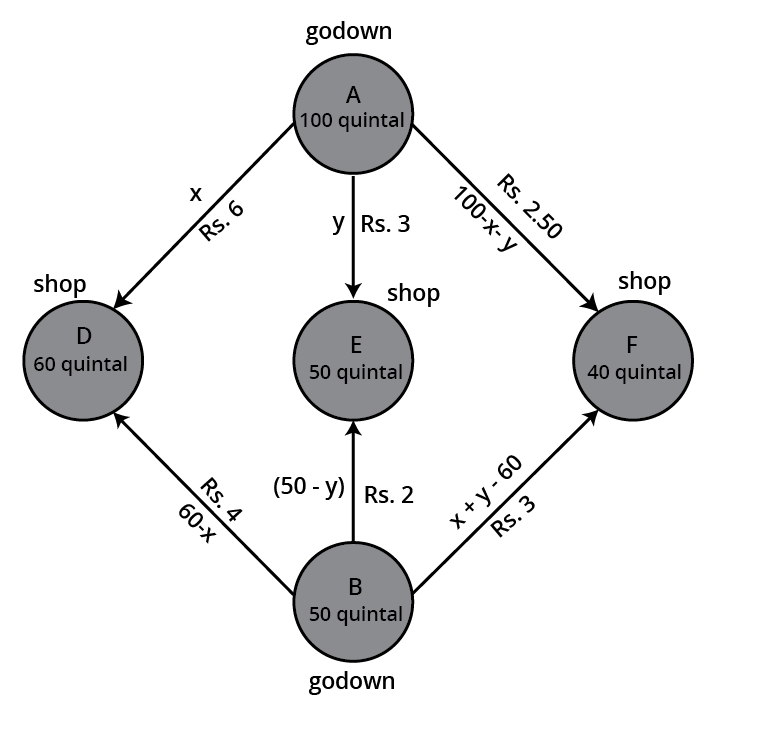
$x \geqslant 0,y \geqslant 0$, and $100 - x - y \geqslant 0$
$ \Rightarrow x \geqslant 0,y \geqslant 0$, and $x + y \leqslant 100$
$60 - x \geqslant 0,50 - y \geqslant 0$, and $x + y - 60 \geqslant 0$
$ \Rightarrow x \leqslant 60,y \leqslant 50$, and $x + y \geqslant 60$
Total transportation cost $z$ is given by,
$z = 6x + 3y + 2.5(100 - x - y) + 4(60 - x) + 2(50 - y) + 3(x + y - 60)$
$ = 6x + 3y + 250 - 2.5x - 2.5y + 240 - 4x + 100 - 2y + 3x + 3y - 180$
$ = 2.5x + 1.5y + 410$
The given problem can be formulated as Minimize $z = 2.5x + 1.5y + 410 \ldots $ (1)
subject to the constraints,
$x + y \leqslant 100$ ………..(II)
$x \leqslant 60$ ……………..(III)
$y \leqslant 50$ ……………..(iv)
$x + y \geqslant 60$ ………….(v)
$x,y \geqslant 0$ ……………..(vi)
The feasible region determined by the system of constraints is as follows.

The corner points are\[A{\text{ }}\left( {60,{\text{ }}0} \right),{\text{ }}B{\text{ }}\left( {60,{\text{ }}40} \right),{\text{ }}C{\text{ }}\left( {50,{\text{ }}50} \right),{\text{ }}and{\text{ }}D{\text{ }}(10,{\text{ }}50\]). The values of z at these corner points are as follows.
Corner points | \[Z{\text{ }} = {\text{ }}2.5x{\text{ }} + {\text{ }}1.5y{\text{ }} + {\text{ }}410\] |
A (60,0) | 560 |
B (60,40) | 620 |
C (50,50) | 610 |
D (10,50) | 510 |
The minimum value of z is 510 at (10, 50).
Thus, the amount of grain transported from A to D, E, and F is 10 quintals, 50 quintals, and 40 quintals respectively and from B to D, E, and F is 50 quintals, 0 quintals, and 0 quintals respectively.
14. An Aero plane can carry a maximum of 200 passengers. A profit of Rs. 400 is made on each first-class ticket and a profit of Rs. 300 is made on each second-class ticket. The airline reserves at least 20 seats for first class. However at least four times as many passengers prefer to travel by second class than by first class. Determine, how many tickets of each type must be sold to maximize profit for the airline.
Ans:
Let there be x tickets of executive class and y tickets of economy class. Let Z be net profit of the airline.
Here, we have to maximize z.
Now
\[\begin{array}{*{20}{l}} {Z{\text{ }} = {\text{ }}500x\;{\text{ }}x{\text{ }}80/100{\text{ }} + {\text{ }}y{\text{ }}x{\text{ }}75/100} \\ {\;Z{\text{ }} = {\text{ }}400x{\text{ }} + {\text{ }}300y{\text{ }}....\left( I \right)\;} \end{array}\]
According to question
\[x\; \geqslant \;20{\text{ }}....\left( {ii} \right)\;\]
Also
\[\begin{array}{*{20}{l}} {x{\text{ }} + {\text{ }}y\; \leqslant \;200{\text{ }}....\left( {iii} \right)\;} \\ {\; \Rightarrow \;x{\text{ }} + {\text{ }}4x\; \leqslant \;200\;} \\ { \Rightarrow \;5x\; \leqslant \;200\;} \\ {\; \Rightarrow \;x\; \leqslant \;40{\text{ }}....\left( {iv} \right)\;} \end{array}\]
Shaded region is feasible region having corner points \[A{\text{ }}\left( {20,{\text{ }}0} \right),{\text{ }}B{\text{ }}\left( {40,0} \right){\text{ }}C{\text{ }}\left( {40,{\text{ }}160} \right),{\text{ }}D{\text{ }}\left( {20,180} \right)\]
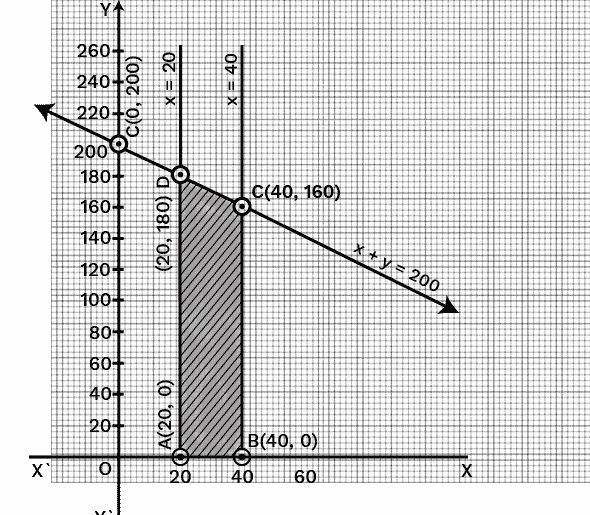
Now value of Z is calculated at corner point as
Corners Points | \[Z{\text{ }} = {\text{ }}400x{\text{ }} + {\text{ }}300y\] |
\[\left( {20,0} \right)\] | \[8,000\] |
\[\left( {40,0} \right)\] | \[16,000\] |
\[\left( {40,160} \right)\] | \[64,000\] |
\[\left( {20,180} \right)\] | \[60,000\] |
Hence, 40 tickets of executive class and 160 tickets of economy class should be sold to maximize the net profit of the airlines.
Yes, more passengers would prefer to travel by such an airline, because some amount of profit is invested for welfare fund.
15. A diet for a sick person must contain at least \[{\mathbf{4000}}\]units of vitamins, 50 units of minerals and \[{\mathbf{1400}}\]units of calories. Two foods A and B are available at a cost of Rs. 5 and Rs. 4 per unit respectively. One unit of food A contains 200 unit of vitamins, 1 unit of minerals and 40 units of calories whereas one unit of food B contains 100 units of vitamins, 2 units of minerals and 40 units of calories. Find what combination of the food A and B should be used to have least cost but it must satisfy the requirements of the sick person.
Ans:
We have,
Let x units of food A
y units of food B
Where \[x \geqslant 0,{\text{ }}y \geqslant 0\]
We are to minimize
\[Z{\text{ }} = {\text{ }}5x{\text{ }} + {\text{ }}4y\]
Subject to constraints
\[200x{\text{ }} + {\text{ }}100y{\text{ }} \geqslant {\text{ }}4000\]
\[\begin{array}{*{20}{l}} {2x{\text{ }} + {\text{ }}y{\text{ }} \geqslant {\text{ }}40\;\;\;\;\;.....\left( 1 \right)} \\ {X{\text{ }} + {\text{ }}2y{\text{ }} \geqslant {\text{ }}50\;\;\;\;\;.....\left( 2 \right)} \\ {40x{\text{ }} + {\text{ }}40y{\text{ }} \geqslant {\text{ }}1400} \\ {X{\text{ }} + {\text{ }}y{\text{ }} \geqslant {\text{ }}35\;\;\;\;\;\;.......\left( 3 \right)} \end{array}\]Where,
\[x{\text{ }} \geqslant {\text{ }}0,{\text{ }}y{\text{ }} \geqslant {\text{ }}0\]
From equation (1) to and we get,
\[\begin{array}{*{20}{l}} {2x{\text{ }} + {\text{ }}y{\text{ }} = {\text{ }}40} \\ {If\;x = 0\;then\;y{\text{ }} = {\text{ }}40OY{\text{ }}in\;L{\text{ }}\left( {0,40} \right)} \\ {If\;y = 0\;then\;x{\text{ }} = 20OX{\text{ }}in\;A{\text{ }}\left( {20,0} \right)} \end{array}\]
From equation (2) to and we get,
\[\begin{array}{*{20}{l}} {X{\text{ }} + {\text{ }}2y{\text{ }} = {\text{ }}50} \\ {If\;x = 0\;then\;y = 25OY{\text{ }}in\;M{\text{ }}\left( {0,25} \right)} \\ {If\;y = 0\;then\;x = 50OX{\text{ }}in\;B{\text{ }}\left( {50,0} \right)} \end{array}\]
From equation (3) to and we get,
\[\begin{array}{*{20}{l}} {X{\text{ }} + {\text{ }}y{\text{ }} = {\text{ }}35} \\ {If\;x = 0\;then\;y = {\text{ }}35OY{\text{ }}in\;N{\text{ }}\left( {0,35} \right)} \\ {If\;y = 0\;then\;x = {\text{ }}35OX{\text{ }}in\;C{\text{ }}\left( {35,0} \right)} \end{array}\]
Shaded region is the feasible region, which is unbounded.
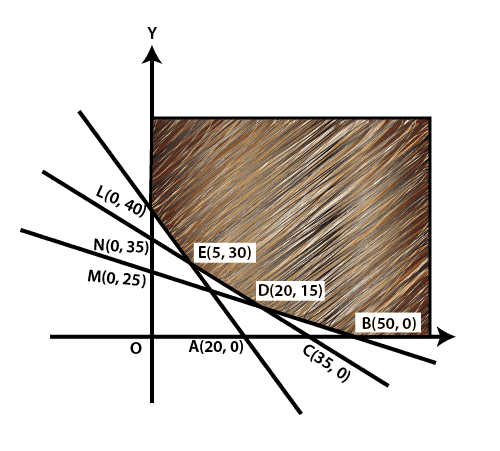
Then,
Corner point is
\[\begin{array}{*{20}{l}} {B{\text{ }}\left( {50,0} \right)} \\ {D{\text{ }}\left( {20,15} \right)} \\ {E{\text{ }}\left( {5,30} \right)} \\ {L{\text{ }}\left( {0,40} \right)} \end{array}\]
\[\begin{array}{*{20}{l}} {At{\text{ }}point\;B{\text{ }}\left( {50,0} \right) \Rightarrow Z = 5\left( {50} \right){\text{ }} + {\text{ }}4\left( 0 \right){\text{ }} = {\text{ }}250} \\ {At{\text{ }}point\;D{\text{ }}\left( {20,15} \right),{\text{ }}Z = 5\left( {20} \right){\text{ }} + {\text{ }}4\left( {15} \right){\text{ }} = {\text{ }}100 + 60 = 160} \\ {At{\text{ }}point\;E{\text{ }}\left( {5,30} \right),{\text{ }}Z = 5\left( 5 \right){\text{ }} + {\text{ }}4\left( {30} \right){\text{ }} = {\text{ }}25 + 120 = 145} \\ {At{\text{ }}point\;L{\text{ }}\left( {0,40} \right),{\text{ }}Z = 5\left( 0 \right){\text{ }} + {\text{ }}4\left( {40} \right){\text{ }} = {\text{ }}0 + 160 = 160} \\ {Then{\text{ }}at{\text{ }}least{\text{ }}cost\; = Rs145{\text{ }}at{\text{ }}\left( {5,30} \right)} \end{array}\]
Food A: 5 units, Food B: 30 units.
Significance of CBSE Class 12 Maths Chapter 12 Linear programming Important Questions
As mentioned earlier, this chapter holds immense importance in the Class 12 Maths syllabus as it introduces the concepts and principles of linear programming to the students. Preparing this chapter will need the complete study material along with the important questions suggested by the experts.
These questions have been formulated by following the latest CBSE syllabus to cover the use of all concepts and formulas taught in the chapter. Hence, adding these questions and answers to your practice sessions will be very fruitful in terms of conceptual development.
Benefits of CBSE Class 12 Maths Chapter 12 Linear programming Important Questions
Explore the advantages of delving into CBSE Class 12 Maths Chapter 12 - Linear Programming through its pivotal set of important questions. Discover how these questions can aid in grasping the core concepts, reinforcing knowledge, and ultimately mastering the complex principles of Linear Programming for enhanced understanding. Here are few points:
Focus on key topics for efficient studying.
Prepares students for exams and reduces anxiety.
Reinforces understanding of fundamental concepts.
Teaches effective time management.
Enables self-assessment and progress tracking.
Strategic approach for higher scores.
Covers a wide range of topics for comprehensive understanding.
Supports exam preparation and boosts confidence.
Download CBSE Class 12 Maths Chapter 12 Linear programming Important Questions PDF
Get the PDF version of these questions and answers for free and learn how to solve such problems of linear programming faster. Use your study time efficiently by imbibing the answering styles given in the solutions to score more in the exams.
Conclusion
Reviewing all the crucial questions for Class 12 Maths Chapter 12 - Linear Programming provides students with a solid grasp of the chapter's topics. The extra and important questions for Class 12 Maths Chapter 12 - Linear Programming engage in a concept-focused discussion, encompassing all chapter themes. This question-and-answer method proves time-saving during exam prep, offering an efficient way to revise the chapter and enhance understanding. Practicing these important questions streamlines preparation and boosts confidence for the upcoming exams.
Related Study Materials for Class 12 Maths Chapter 12 Linear Programming
S. No | Study Materials for Class 12 Maths Chapter 12 Linear Programming |
1. | |
2. | |
3. | CBSE Class 12 Maths Chapter 12 Linear Programming NCERT Exemplar |
CBSE Class 12 Maths Chapter-wise Important Questions
CBSE Class 12 Maths Chapter-wise Important Questions and Answers cover topics from all 13 chapters, helping students prepare thoroughly by focusing on key topics for easier revision.
S. No | Chapter-wise Important Questions for Class 12 Maths |
1 | |
2 | Chapter 2 - Inverse Trigonometric Functions Important Questions |
3 | |
4 | |
5 | Chapter 5 - Continuity and Differentiability Important Questions |
6 | |
7 | |
8 | |
9 | |
10 | |
11 | |
12 |
Additional Study Materials for Class 12 Maths
S.No | Study Materials for Class 12 Maths |
1 | |
2 | |
3 | |
4 | |
5 | |
6 | |
7 | |
8 |
FAQs on Important Questions for CBSE Class 12 Maths Chapter 12 - Linear Programming 2024-25
1. How can I learn the methods of solving linear programming questions?
Concentrate on the concepts and follow the solutions given for the NCERT exercises and important questions to learn these methods.
2. Is it important to practise the important questions of linear programming?
Solving these questions will broaden your preparation level for this chapter. You will learn new answering skills from the solutions.
3. Are these questions important for the Class 12 Maths exam?
These questions are suggested by the experts after following the CBSE syllabus and are important to practise.
4. How can I complete preparing Class 12 Maths Linear Programming?
Follow the theoretical explanation first and then solve the exercises. Proceed to solve the important questions and follow the solutions. This is how you can complete preparing this chapter.
5. Where can I get the solutions to these important questions?
The solutions are provided in the same file along with the important questions for your convenience.

















